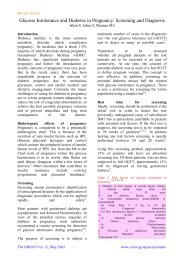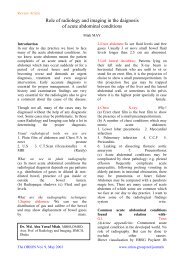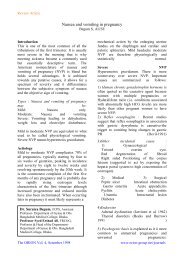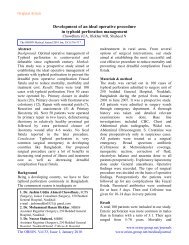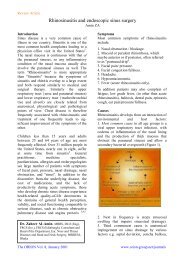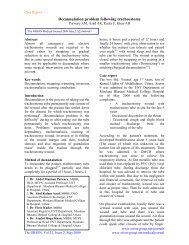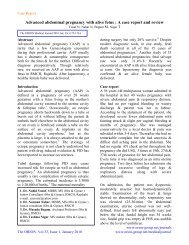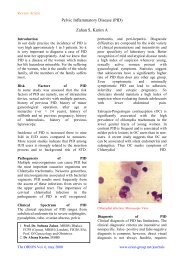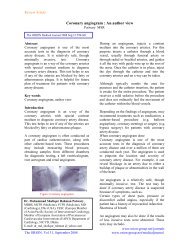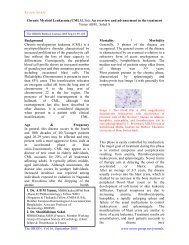Study on heart rate variability in adolescent male ... - Orion Group
Study on heart rate variability in adolescent male ... - Orion Group
Study on heart rate variability in adolescent male ... - Orion Group
You also want an ePaper? Increase the reach of your titles
YUMPU automatically turns print PDFs into web optimized ePapers that Google loves.
Orig<strong>in</strong>al Article<str<strong>on</strong>g>Study</str<strong>on</strong>g> <strong>on</strong> <strong>heart</strong> <strong>rate</strong> <strong>variability</strong> <strong>in</strong> <strong>adolescent</strong> <strong>male</strong>athletes by time doma<strong>in</strong> (Short-Term) methodAlom MM, Begum N, Naher LAD, Kabir R, Faruky SB, Akhter NThe ORION Medical Journal 2010 Jan; 33(1):722-725AbstractBackground: Cardiac Aut<strong>on</strong>omic NervousActivities (CANA) deterio<strong>rate</strong>s with age,obesity, sedentary life style and <strong>in</strong> variouscardiac and n<strong>on</strong>cardiac disease c<strong>on</strong>diti<strong>on</strong>s.Regular physical exercise may improve CANA<strong>in</strong> health and diseases. Analysis of Heart RateVariability (HRV) by time doma<strong>in</strong> method is<strong>on</strong>e of the most promis<strong>in</strong>g newer techniques toquantify CANA. Hypothesis: Regular physicalexercise improves cardiac aut<strong>on</strong>omic nervousactivities. Objective: To observe the HRVparameters by time doma<strong>in</strong> method, <strong>in</strong> <strong>male</strong><strong>adolescent</strong> athletes <strong>in</strong> order to f<strong>in</strong>d out the<strong>in</strong>fluence of regular physical exercise <strong>on</strong>CANA. Method: The cross secti<strong>on</strong>al study wascarried out <strong>on</strong> 62 <strong>adolescent</strong> <strong>male</strong> athletes aged12-18 years (group B), <strong>in</strong> the Department ofPhysiology, Bangabandhu Sheikh MujibMedical University from 1st July 2007 to 30thJune 2008. For comparis<strong>on</strong> 30 age, sex andsocioec<strong>on</strong>omic c<strong>on</strong>diti<strong>on</strong> matched apparentlyhealthy sedentary subjects (group A) were alsostudied. The study group was selected from theBKSP (Bangladesh Krira Shikka Prothistan,Savar, Dhaka) and the c<strong>on</strong>trol from aresidential Madrasha (sedentary life style) ofDhaka city. HRV parameters were assessed by1. Dr. Md. Mashudul Alom, MBBS, M PhilAssistant Professor of Physiology, Sylhet Women'sMedical College, Sylhete-mail : masud_physiol@yahoo.com2. Prof. Noorzahan Begum, MBBS, M Phil, FCPS,FACP, Professor of Physiology, Department ofPhysiology, BSMMU3. Dr. Latifa Afr<strong>in</strong> Dill Nahar, MBBS, M PhilAssistant Professor, Prime Medical College, Rangpur4. Dr. Rasel Kabir, MBBS, M PhilAssistant Professor, Z.H Sikder Medical College,Dhaka5. Dr. Salma B<strong>in</strong>tey Faruky, MBBS, M PhilSenior Lecturer, Bangladesh Medical College, Dhaka6. Dr. Nilufa Akhter, MBBS, M PhilAssistant. Professor, Dhaka Shishu Hospital, DhakaThe ORION. Vol 33, Issue 1, January 2010Polygraph (Polyrite D, versi<strong>on</strong> 2.2). Forstatistical analysis Idependent-Samples t-testwas d<strong>on</strong>e as applicable. Results: Mean R-R<strong>in</strong>terval and SDNN were significantly(P
Orig<strong>in</strong>al ArticleCANA was also observed <strong>in</strong> disease c<strong>on</strong>diti<strong>on</strong>slike <strong>in</strong> Myocardial Infarcti<strong>on</strong>, 24,25 Cor<strong>on</strong>aryartery disease, 26,27 Heart failure, 28,29,30 Obesity, 31type 2 Diabetes, 17, 32 Renal disease. 33Though, it was evident that regular physicalexercise improves CANA <strong>in</strong> health anddiseases by large number of studies; yet, a fewgroup of <strong>in</strong>vestigators, failed to prove thatimprovement <strong>in</strong> healthy <strong>in</strong>dividuals. 34,35,36Aga<strong>in</strong>, some other group of <strong>in</strong>vestigatorsshowed that physical exercise does notimprove, even <strong>in</strong> some cases deterio<strong>rate</strong>sCANA <strong>in</strong> disease c<strong>on</strong>diti<strong>on</strong>s. 37, 38,39,40 Thus, the<strong>in</strong>fluence of physical exercise <strong>on</strong> CANArema<strong>in</strong>s still c<strong>on</strong>troversial.Analysis of HRV by time doma<strong>in</strong> method toquantify CANA has now become popularworld-wide because it is <strong>in</strong>dependent, n<strong>on</strong><strong>in</strong>vasive,accu<strong>rate</strong>, could be easily available and<strong>in</strong> some extent detailed <strong>in</strong>formative. In timedoma<strong>in</strong> method standard deviati<strong>on</strong> of thenormal-to-normal (NN) <strong>in</strong>tervals (that is<strong>in</strong>tervals between adjacent QRS complexesresult<strong>in</strong>g from the s<strong>in</strong>us node depolarizati<strong>on</strong>s)that is SDNN <strong>in</strong>dicate the global <strong>variability</strong> thatis the total change <strong>in</strong> the CANA. A highervalue of SDNN <strong>in</strong>dicates <strong>in</strong>creased and a lowervalue <strong>in</strong>dicates reduced HRV or CANA. 2In Bangladesh, the number of patients withDiabetes, Cardiac diseases and Renal failureare <strong>in</strong>creas<strong>in</strong>g day by day. Aga<strong>in</strong>, a largenumber of people <strong>in</strong> our country may found tobe affected from Aut<strong>on</strong>omic Nerve Dysfuncti<strong>on</strong>due to under or over nutriti<strong>on</strong>. In additi<strong>on</strong>, dueto rapid urbanizati<strong>on</strong> and mechanizati<strong>on</strong> of life,sedentary life style may affect CANA <strong>in</strong> all agegroups. Therefore, people should be aware ofthe adverse effect of sedentary life and alsoabout the usefulness of physical exercise as apreventive and prognostic measure.Though, <strong>in</strong> our country, several studies wered<strong>on</strong>e to assess the CANA <strong>in</strong> Diabetes, 41 ag<strong>in</strong>g 40and obesity 15 by c<strong>on</strong>venti<strong>on</strong>al method; but, nostudy was undertaken to document the changesThe ORION. Vol 33, Issue 1, January 2010of HRV as a result of physical exercise bymicrocomputer based time doma<strong>in</strong> method.Therefore, this study was carried out toevaluate the CANA, by analysis of HRV bytime doma<strong>in</strong> method, <strong>in</strong> healthy <strong>adolescent</strong><strong>male</strong> athletes who perform regular physicalexercise and also <strong>in</strong> healthy <strong>adolescent</strong> <strong>male</strong>with sedentary life style.MethodsThis cross-secti<strong>on</strong>al study was carried out <strong>in</strong> thedepartment of physiology of BangabandhuSheikh Mujib Medical University from July2007 to June 2008. Departmental EthicalCommittee approved the protocol.Total 92 apparently healthy <strong>male</strong> <strong>adolescent</strong>sage ranged from 12-18 years were selected, ofwhom 30 were n<strong>on</strong>-athletes sedentary taken asc<strong>on</strong>trol (<strong>Group</strong> A) and 62 were athletes selectedas experimental (<strong>Group</strong> B). C<strong>on</strong>trol (<strong>Group</strong> A)was selected from a Madrasha (a residentialIslamic school) <strong>in</strong> Dhaka city and the study(<strong>Group</strong> B) was from Bangladesh Krira ShikkhaProthistan ( BKSP - the top most residentialsports academy <strong>in</strong> Bangladesh). All the c<strong>on</strong>trolsubjects were used to ma<strong>in</strong>ta<strong>in</strong> a sedentary lifestyle while the experimental subjects wereexposed to regular physical exercise for at least<strong>on</strong>e year. The subjects were excluded for anysystemic diseases, drug user specially drugaffect<strong>in</strong>g nervous system and smoker. Allethical c<strong>on</strong>siderati<strong>on</strong>s for the subjects weretaken <strong>in</strong>to account before <strong>in</strong>clusi<strong>on</strong> <strong>in</strong> to thestudy. The aims and benefits of the study wereexpla<strong>in</strong>ed to each subject and were encouragedto participate voluntarily. A written <strong>in</strong>formedc<strong>on</strong>sent was taken from each subjects and theirauthority. A detail physical activity, medical,pers<strong>on</strong>al, socio-ec<strong>on</strong>omic history was taken andthorough cl<strong>in</strong>ical exam<strong>in</strong>ati<strong>on</strong> of the subjectswas d<strong>on</strong>e. All these <strong>in</strong>formati<strong>on</strong> were recorded<strong>in</strong> a prepared questi<strong>on</strong>naire. The subjects wereadvised to have his meal by 9:00 p.m., torema<strong>in</strong> free from any physical and mentalstress, not to take any drugs affect<strong>in</strong>g nervoussystem and to have a good sleep at night beforewww.ori<strong>on</strong>-group.net/journalswww.ori<strong>on</strong>-group.net/medicaljournal
Orig<strong>in</strong>al Articlethe exam<strong>in</strong>ati<strong>on</strong> day. The subject was alsoasked to avoid tea or coffee at breakfast and toattend at the aut<strong>on</strong>omic nerve functi<strong>on</strong>laboratory between 9:00 am to 11:00 am <strong>on</strong> theday of exam<strong>in</strong>ati<strong>on</strong>. On the day of exam<strong>in</strong>ati<strong>on</strong>,after detailed history and all physicalexam<strong>in</strong>ati<strong>on</strong>s, the subject was kept undercomplete bed rest <strong>in</strong> sup<strong>in</strong>e positi<strong>on</strong> for 20m<strong>in</strong>utes <strong>in</strong> a cool and calm envir<strong>on</strong>ment at"Aut<strong>on</strong>omic Nerve Functi<strong>on</strong> Test Laboratory"of the department of physiology. Dur<strong>in</strong>g thisperiod he was restricted to talk, eat, dr<strong>in</strong>k, anyphysical or mental activity and even sleep.Then all preparati<strong>on</strong>s for record<strong>in</strong>g of the <strong>heart</strong><strong>rate</strong> <strong>variability</strong> parameters was made byc<strong>on</strong>nect<strong>in</strong>g the channels i.e. the channels forECG of Polyrite-D (RMS INDIA Versi<strong>on</strong>-2.2).Then five m<strong>in</strong>utes record<strong>in</strong>g was taken <strong>in</strong>rest<strong>in</strong>g sup<strong>in</strong>e positi<strong>on</strong>. After record<strong>in</strong>g, all then<strong>on</strong>-s<strong>in</strong>us beats were filtered out from the ECGand the time doma<strong>in</strong> parameters of the HRV(R-R <strong>in</strong>terval, <strong>heart</strong> <strong>rate</strong> and SDNN) wereobta<strong>in</strong>ed from the time series. Then, with allaseptic precauti<strong>on</strong>, 5ml of venous blood wasdrawn from the subject <strong>in</strong> order to measureserum glucose and creat<strong>in</strong><strong>in</strong>e levels to excludediabetes and kidney diseases.All datas were recorded systematically <strong>in</strong>preformed data collecti<strong>on</strong> form and expressedas mean±SD. Statistical analysis was performedby us<strong>in</strong>g SPSS for w<strong>in</strong>dows versi<strong>on</strong> 12.0.Independent-Samples t-test was performed tocompare the data between the c<strong>on</strong>trol and studygroup. 95% c<strong>on</strong>fidence limit (p
Orig<strong>in</strong>al Articlesubjects were analyzed by microcomputerbased polygraphic recorder (Polyrite D, RMSIndia versi<strong>on</strong> 2.2). All these time doma<strong>in</strong> HRVparameters were also studied <strong>in</strong> age and sexmatched healthy sedentary subjects for c<strong>on</strong>trol.and also to f<strong>in</strong>d out their basel<strong>in</strong>e data <strong>in</strong> thisgroup of populati<strong>on</strong>.In this study, all the time doma<strong>in</strong> HRVparameters <strong>in</strong> the healthy c<strong>on</strong>trol subjects werewith<strong>in</strong> normal ranges and are comparable withthe f<strong>in</strong>d<strong>in</strong>gs of the Task Force Guidel<strong>in</strong>es. 2Serum Glucose and Creat<strong>in</strong><strong>in</strong>e levels <strong>in</strong> all thesubjects were with<strong>in</strong> normal range and werestudied for exclusi<strong>on</strong> of Diabetes Mellitus andkidney diseases.In the present study, Mean R-R <strong>in</strong>terval wassignificantly (P
Orig<strong>in</strong>al Articlethat regular physical exercise is helpful toma<strong>in</strong>ta<strong>in</strong> normal/ better CANA and thereby isbeneficial <strong>in</strong> prevent<strong>in</strong>g the occurrence ofdifferent cardiac diseases due to CardiacAut<strong>on</strong>omic Neuropathy.References1. Bilman GE, Aerobic exercise c<strong>on</strong>diti<strong>on</strong><strong>in</strong>g: an<strong>on</strong>pharmacologicalantiarrhythmic<strong>in</strong>terventi<strong>on</strong>. J Appl Physiol. 2002; 92: 446-454.2. Task Force of The European Society ofCardiology and The North American Society ofSpac<strong>in</strong>g and Electrophysiology. Heart RateVariability: standards of measurement,physiological <strong>in</strong>terpretati<strong>on</strong> and cl<strong>in</strong>icaluse.Circulati<strong>on</strong>.1996; 93:1043-1065.3. O'Brien IAD, O'Hare P, CoR-Rall RJM.Heart <strong>rate</strong> <strong>variability</strong> <strong>in</strong> healthy subjects: effectof age and the derivati<strong>on</strong> of normal ranges fortests of aut<strong>on</strong>omic functi<strong>on</strong>. Br Heart J. 1986;55:348-354.4. Yeragani VK, Sobolewski E, Kay J, JampalaVC, Igel G. Effect of age <strong>on</strong> l<strong>on</strong>g-term <strong>heart</strong><strong>rate</strong> <strong>variability</strong>. Cardiovasc Res.1997; 35(1):35-42.5. Dix<strong>on</strong> EM, Kamath MV, McCartney N,Fallen L. Neural regulati<strong>on</strong> of <strong>heart</strong> <strong>rate</strong><strong>variability</strong> <strong>in</strong> endurance athletes and sedentaryc<strong>on</strong>trols. Cardiovasc Res. 1992; 26(7): 713 - 9.6. Janssen MJ, de Bie J, Swenne CA, Oudhof J.Sup<strong>in</strong>e and stand<strong>in</strong>g sympathovagal balance <strong>in</strong>athletes and c<strong>on</strong>trols. Eur J Appl Physiol OccupPhysiol.1993; 67 (2): 164 -7.7. Casolo GC, Stroder P, Signor<strong>in</strong>i C, CalzolariF, Zucch<strong>in</strong>i M, Balli E, Sulla A, Lazzer<strong>in</strong>i S.Heart <strong>rate</strong> <strong>variability</strong> dur<strong>in</strong>g the acute phase ofmyocardial <strong>in</strong>farcti<strong>on</strong>. Circulati<strong>on</strong>. 1992; 85:2073-2079.8. Wichterle D, Simek J, La Rovere MT,Schwartz PJ, Camm J, Malik M. PrevalentLow-frequency oscillati<strong>on</strong> of <strong>heart</strong> <strong>rate</strong>: Novelpredictor of mortality after myocardial<strong>in</strong>farcti<strong>on</strong>. Circulati<strong>on</strong>. 2004; 110:1183-90.9. La Rovere MT, P<strong>in</strong>na GD, Maestri R,Mortara A, Capomolla S, Febo O, FeR-Rari R,Franch<strong>in</strong>i M, Gnemmi M, Opasich C, RiccardiPG, Traversi E, Cobelli F. Short-term <strong>heart</strong> <strong>rate</strong>The ORION. Vol 33, Issue 1, January 2010<strong>variability</strong> str<strong>on</strong>gly predicts sudden cardiacdeath <strong>in</strong> chr<strong>on</strong>ic <strong>heart</strong> failure patients.Circulati<strong>on</strong>. 2003; 107:565-570.10. Guzzetti S, Dassi S, Pecis M. Alteredpattern of circadian neural c<strong>on</strong>trol of heatperiod <strong>in</strong> mild hypertensi<strong>on</strong>. J Hypertens.1991;9: 831-838.11. Counihan PJ, Fer L, Bashir Y, FaR-Rel TG,Haywood GA, McKenna WJ, Assessment of<strong>heart</strong> <strong>rate</strong> <strong>variability</strong> <strong>in</strong> hypertrophiccardiomyopathy Associati<strong>on</strong> with cl<strong>in</strong>ical andprognostic features. Circulati<strong>on</strong>. 1993; 88:1682-1690.12. Sands KE, Appel ML, Lilly S, Schoen FJ,Mudge GH, Cohen RJ. Power spectra analysisof <strong>heart</strong> <strong>rate</strong> <strong>variability</strong> <strong>in</strong> human cardiactransplant recipients. Circulati<strong>on</strong>. 1989; 79: 76-82.13. Huikuri HV, Valkama JO, Airaks<strong>in</strong>en KEJ.Frequency doma<strong>in</strong> measures of <strong>heart</strong> <strong>rate</strong><strong>variability</strong> before the <strong>on</strong>set of n<strong>on</strong>susta<strong>in</strong>ed andsusta<strong>in</strong>ed ventricular tachycardia <strong>in</strong> patientswith cor<strong>on</strong>ary artery diseases.Circulati<strong>on</strong>. 1993;87: 1220-1228.14. Huikuri HV, L<strong>in</strong>naluoto MK, Seppanen T.Circadian rhythm of <strong>heart</strong> <strong>rate</strong> <strong>variability</strong> <strong>in</strong>survivors of cardiac aR-Rest. Am JCardiol.1992; 70: 610-615.15. Akhter S. Relati<strong>on</strong>ship between obesity andaut<strong>on</strong>omic nerve functi<strong>on</strong> activity. [Thesis][Dhaka (Bangladesh)]: BSMMU. 2007.16. Kudat H, Akkaya V, Sozen AB, Salman S,Demirel S, Ozcan M, Atilgan D, Yilmaz MT,Guven O. Heart <strong>rate</strong> <strong>variability</strong> <strong>in</strong> diabetespatients. J Int Med Res. 2006; 34(3): 291-6.17. Pagkalos M, Koutlianos N, Kouidi E,Pagakalos E, Mandroukas K, Deligiannis A.Heart <strong>rate</strong> <strong>variability</strong> modificati<strong>on</strong>s follow<strong>in</strong>gexercise tra<strong>in</strong><strong>in</strong>g <strong>in</strong> type 2 diabetic patients withdef<strong>in</strong>ite cardiac aut<strong>on</strong>omic neuropathy. Br JSports Med. 2008; 42: 47-54.18. Mario vaz, Bharati AV, Suchitra S,Nazareth D. Heart <strong>rate</strong> <strong>variability</strong> andBaroreflex sensitivity are reduced <strong>in</strong>chr<strong>on</strong>ically undernourished , but otherwisehealthy, human subjects. Cl<strong>in</strong> Sci. 2003;104:295 -302.www.ori<strong>on</strong>-group.net/journalswww.ori<strong>on</strong>-group.net/medicaljournal
Orig<strong>in</strong>al Article37. Mazzuero G, Lanfranchi P, Colombo R,Giannuzzi P, Giordano A. L<strong>on</strong>g- termadaptati<strong>on</strong> of 24-h <strong>heart</strong> <strong>rate</strong> <strong>variability</strong> aftermyocardial <strong>in</strong>farcti<strong>on</strong>. The EAMI <str<strong>on</strong>g>Study</str<strong>on</strong>g> <strong>Group</strong>.Exercise Tra<strong>in</strong><strong>in</strong>g <strong>in</strong> Anterior MyocardialInfarcti<strong>on</strong>. Chest.1992; 101:304-308.38. Leitch JW, Newl<strong>in</strong>g RP, Basta M, Inder K,Dear K, Fletcher PJ.Randomized trial of ahospital-based exercise tra<strong>in</strong><strong>in</strong>g program afteracute myocardial <strong>in</strong>farcti<strong>on</strong>: cardiac aut<strong>on</strong>omiceffects. J Am Coll Cardiol. 1997; 29(6): 1263-8.39. Davy KP, Willis WL, Seals DR. <strong>in</strong>fluenceof exercise tra<strong>in</strong><strong>in</strong>g <strong>on</strong> <strong>heart</strong> <strong>rate</strong> <strong>variability</strong> <strong>in</strong>post-menopausal women with elevated arterialblood pressure. Cl<strong>in</strong> Physiol. 1997; 17(1): 31-40.40. Figueroa A, Baynard T, Fernhall B, CarhartR, Kanaley JA. Endurance tra<strong>in</strong><strong>in</strong>g improvespost-exercise cardiac aut<strong>on</strong>omic modulati<strong>on</strong> <strong>in</strong>obese women with and without type 2 diabetes.Eur J Appl Physiol. 2007; 100(4): 437-444.41. Alom MK. Aut<strong>on</strong>omic nerve functi<strong>on</strong>status <strong>in</strong> type-2 diabetes, relati<strong>on</strong> to glycaemicstatus, durati<strong>on</strong> and i<strong>on</strong>ized serum calcium andmagnesium c<strong>on</strong>centrati<strong>on</strong>. [Thesis] [Dhaka(Bangladesh)]: BSMMU. 2004.42. Islam T. Assessment of some aspects ofaut<strong>on</strong>omic nerve functi<strong>on</strong> status <strong>in</strong> healthyelderly subjects. [Thesis] [Dhaka(Bangladesh)]: BSMMU. 2006.43. Iellamo F, Legramante JM, Pigozzi F,Spataro A, Norbiato G, Luc<strong>in</strong>i D, Pagani M.C<strong>on</strong>versi<strong>on</strong> from vagal to sympatheticpredom<strong>in</strong>ance with strenuous tra<strong>in</strong><strong>in</strong>g <strong>in</strong> highperformance world class athletes. Circulati<strong>on</strong>.2002; 105: 2719-2724.44. Seals DR, Chase PB. Influence of physicaltra<strong>in</strong><strong>in</strong>g <strong>on</strong> <strong>heart</strong> <strong>rate</strong> <strong>variability</strong> and baroreflexcirculatory c<strong>on</strong>trol. J Appl Physiol.1989;66:1886-1895.45. Al-Ani M, Munir SM, White M, TownendJ, Coote JH. Changes <strong>in</strong> R-R <strong>variability</strong> beforeand after endurance tra<strong>in</strong><strong>in</strong>g measured bypower spectral analysis and by the effect ofisometric muscle c<strong>on</strong>tracti<strong>on</strong>. Eur J ApplPhysiol Occup Physiol. 1996; 74(5): 397-403.The ORION. Vol 33, Issue 1, January 201046. Iwasaki K, Zhang R, Zuckerman JH, Lev<strong>in</strong>eBD. Dose-resp<strong>on</strong>se relati<strong>on</strong>ship of thecardiovascular adaptati<strong>on</strong> to endurance tra<strong>in</strong><strong>in</strong>g<strong>in</strong> healthy adults: how much tra<strong>in</strong><strong>in</strong>g for whatbenefit? J Appl Physiol. 2003; 95:1575-1583.47. Leicht AS, Allen GD, Hoey AJ. Influenceof <strong>in</strong>tensive cycl<strong>in</strong>g tra<strong>in</strong><strong>in</strong>g <strong>on</strong> <strong>heart</strong> <strong>rate</strong><strong>variability</strong> dur<strong>in</strong>g rest and exercise. Can J ApplPhysiol. 2003; 28(6): 898-909.48. Jurca R, Church TS, Morss GM, JordanAN, Earnest CP. Eight weeks of mode<strong>rate</strong><strong>in</strong>tensity exercise tra<strong>in</strong><strong>in</strong>g <strong>in</strong>creases <strong>heart</strong> <strong>rate</strong><strong>variability</strong> <strong>in</strong> sedentary post-menopausalwomen. Am Heart J. 2004; 147(5): e21.49. Schuit AJ, van Amelsvoort LG, VerheijTC, Rijneke RD, Maan AC, Swenne CA,Schouten EG. Exercise tra<strong>in</strong><strong>in</strong>g and <strong>heart</strong> <strong>rate</strong><strong>variability</strong> <strong>in</strong> older people. Med Sci SportsExerc. 1999; 31(6): 826-21.50. Ste<strong>in</strong> PK, Ehsani AA, Domitrovich PP,Kleiger RE, Rottman JN. Effect of exercisetra<strong>in</strong><strong>in</strong>g <strong>on</strong> <strong>heart</strong> <strong>rate</strong> <strong>variability</strong> <strong>in</strong> healthy olderadults. Am Heart J. 1999; 138(3): 567-576.51. Buchheit M, G<strong>in</strong>dre C. Cardiacparasympathetic regulati<strong>on</strong>: respectiveassociati<strong>on</strong>s with cardiorespiratory fitness andtra<strong>in</strong><strong>in</strong>g load. Am J Physiol Heart Circ Physiol.2006; 291: H451-H458.52. Raczak G, P<strong>in</strong>na GD, La Rovere MT,Maestri R, Danilowicz L, Ratlowski W, FiguraM, Szwoch M, Ambroch K. Cardiovagalresp<strong>on</strong>ses to acute mild exercise <strong>in</strong> younghealthy subjects. Circ J. 2005; 69(8): 976-80.53. Buchheit M, Sim<strong>on</strong> C, Piquard F, Ehrhart J,Brandenberger G. Effects of <strong>in</strong>creased tra<strong>in</strong><strong>in</strong>gload <strong>on</strong> vagal-related <strong>in</strong>dexes of <strong>heart</strong> <strong>rate</strong><strong>variability</strong>: a novel sleep approach. Am JPhysiol Heart Circ Physiol. 2004; 287: H2813-H2818.54. DeSchryver C, Mertens J. Heart tissueacetylchol<strong>in</strong>e <strong>in</strong> chr<strong>on</strong>ically exercised rats.Experiential. 1975; 31:316-318.55. Holycross BJ, Kukielka M, Nishijima Y,Altschuld RA, Carnes CA, Billman GE.Exercise tra<strong>in</strong><strong>in</strong>g normalizes betaadrenoceptorsexpressi<strong>on</strong> <strong>in</strong> dogs susceptible toventricular fibrillati<strong>on</strong>. Am J Physiol HeartCirc Physiol. 2007; 293(5): H 2702-H2709.www.ori<strong>on</strong>-group.net/journalswww.ori<strong>on</strong>-group.net/medicaljournal



